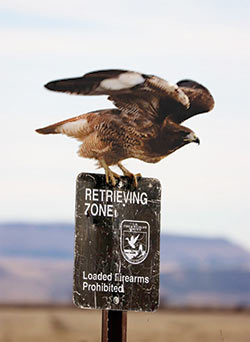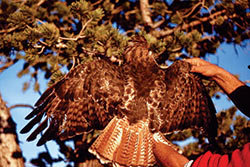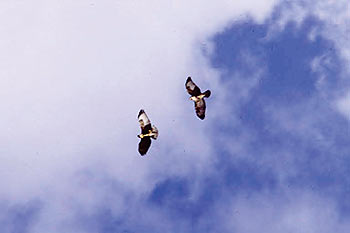 Of all the birds of prey, the red-tailed hawk (Buteo jamaicensis) is the most widespread and widely known. From the high rises of Manhattan to the tropical rainforests of Central America, redtails inhabit a wide variety of habitats. In Utah, these include pinyon-juniper woodlands, open shrublands, riparian woodlands, canyons, agricultural areas, and mountain forests. It’s not uncommon to pass by a ranch home surrounded by several large trees and see a red-tailed hawk’s nest high up in the canopy.
Of all the birds of prey, the red-tailed hawk (Buteo jamaicensis) is the most widespread and widely known. From the high rises of Manhattan to the tropical rainforests of Central America, redtails inhabit a wide variety of habitats. In Utah, these include pinyon-juniper woodlands, open shrublands, riparian woodlands, canyons, agricultural areas, and mountain forests. It’s not uncommon to pass by a ranch home surrounded by several large trees and see a red-tailed hawk’s nest high up in the canopy.
And the redtail’s harsh down-slurred whistled Krre-e-e-err call is beloved by Hollywood often inserting the call into movies or television shows no matter if the bird on the screen is a bald eagle or falcon.
Scientifically, redtails belong to the soaring hawks known as Buteos. The type specimen was collected for science in 1781 in Jamaica; hence, the species name jamaicensis.
In southern Utah, the Buteo group includes ferruginous hawks, Swainson’s hawk (a summer breeder), rough-legged hawk (a winter visitor), and broad-winged hawks (a rare migrant). All share characteristics of large, broad wings and tails which enable the birds to soar effortlessly in search of prey. Of course, the birds also perch and scan the area for prey with their excellent eyesight which is about eight times stronger than a human’s eyesight. This vision enables a redtail to swoop down from a power pole and easily snatch a mouse.
 Redtails have a “seefood” diet – they see prey and eat them. Mammals make up a large portion of the menu: jackrabbits, cottontails, mice, ground squirrels, voles, and prairie dogs but birds, snakes, and carrion. I’ve seen a redtail with a writhing rattlesnake in its talons right before the hawk released the snake from up high to land on some slickrock. These birds have also been observed feeding on grasshoppers fleeing from a wildfire.
Redtails have a “seefood” diet – they see prey and eat them. Mammals make up a large portion of the menu: jackrabbits, cottontails, mice, ground squirrels, voles, and prairie dogs but birds, snakes, and carrion. I’ve seen a redtail with a writhing rattlesnake in its talons right before the hawk released the snake from up high to land on some slickrock. These birds have also been observed feeding on grasshoppers fleeing from a wildfire.
In the Canyonlands region, redtails nest in tall cottonwood trees or on cliff ledges, although large junipers may also house a nest. A nest from a previous year may be reused but often there are several alternative nests nearby from which a breeding pair may choose. Both sexes construct the stick nests, which are often large and lined with strips of bark and perhaps some fresh juniper as an insecticide.
Fledglings leave the nest after about 44 days but the parents will continue to feed the bird for about the next month. Mortality in juvenile raptors is fairly high as the birds have to become successful hunters in a short amount of time.
 A common September sight is a redtail perched on a power pole or soaring overhead. Though identifying the bird while you’re traveling 70 mph might be challenging, know that if you guess “redtail” you’re right about 70 percent of the time due to the commonality of the species.
A common September sight is a redtail perched on a power pole or soaring overhead. Though identifying the bird while you’re traveling 70 mph might be challenging, know that if you guess “redtail” you’re right about 70 percent of the time due to the commonality of the species.
One of the other unique aspects of redtails is the number of subspecies forms and plumage variations. There are light and dark phases and intermediate forms between these extremes, as well as differences between adults and juveniles. A juvenile may be distinguished from its adult plumage by the lack of a brick-red tail. Instead, the juvenile’s tail is browner and heavy banded with dark lines. Other field marks include dark comma-shaped markings on the wings’ underside and dark spots, called patagial marks, on the wings’ undersides.
In the wild, the average life span for a redtail is 6-7 years but on the silver screen, their harsh calls live forever. .